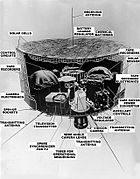Template:Infobox spaceflight
TIROS I (or TIROS-1) was the first successful low-Earth orbital weather satellite, and the first of a series of Television Infrared Observation Satellites.
Launch[]

Instruments and equipment of the TIROS I.
The TIROS-1 spacecraft was launched by NASA and partners at 6:40 AM EST[1] on April 1, 1960, from Cape Canaveral, Florida, in the United States. Mission partners were NASA, the U.S. Army Signal Research and Development Laboratory, RCA, the U.S. Weather Bureau, and the U.S. Naval Photographic Interpretation Center.[2]
Program[]
The TIROS Program (Television Infrared Observation Satellite) was NASA's first experimental step to determine if satellites could be useful in the study of the Earth. At that time, the effectiveness of satellite observations was still unproven. Since satellites were a new technology, the TIROS Program also tested various design issues for spacecraft: instruments, data and operational parameters. The goal was to improve satellite applications for Earth-bound decisions, such as "should we evacuate the coast because of the hurricane?".[2]
The TIROS Program's first priority was the development of a meteorological satellite information system. Weather forecasting was deemed the most promising application of space-based observations.[2]
TIROS proved extremely successful, providing the first accurate weather forecasts based on data gathered from space. TIROS began continuous coverage of the Earth's weather in 1962, and was used by meteorologists worldwide. The program's success with many instrument types and orbital configurations lead to the development of more sophisticated meteorological observation satellites.[2]
References[]
External links[]
- TIROS – NASA Science
- The Smithsonian National Air & Space Museum Exhibition List
- TIROS 1 & 2 Ground Control Canter at Camp Evans - preserved by InfoAge Science History Center
- Published story of how the first TIROS photo was flown by helicopter, then a jet from the Camp Evans Ground Control Center to NASA
- TIROS I is Launched - NOAASIS
Template:TIROS
| This page uses Creative Commons Licensed content from Wikipedia (view authors). | 
|